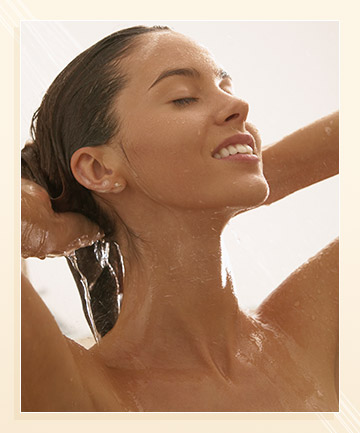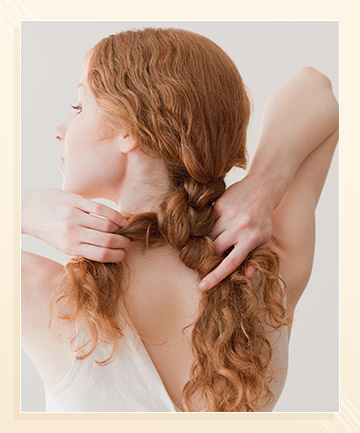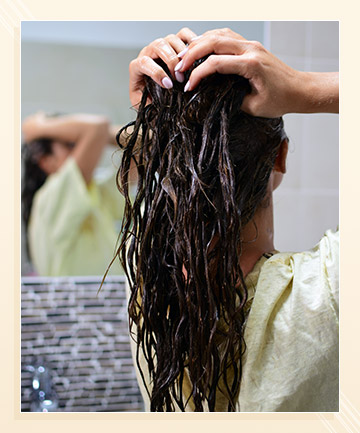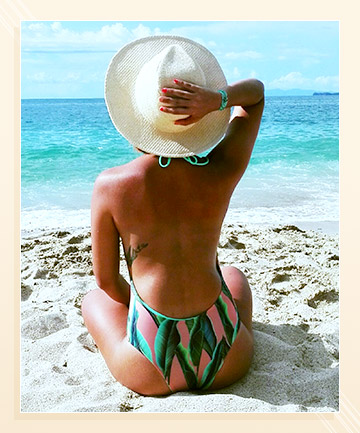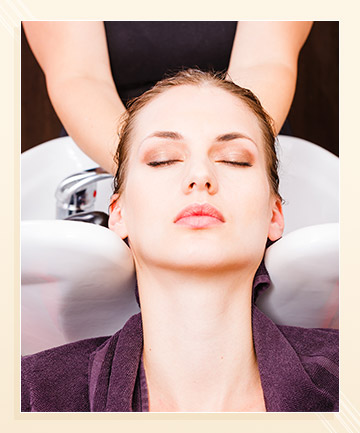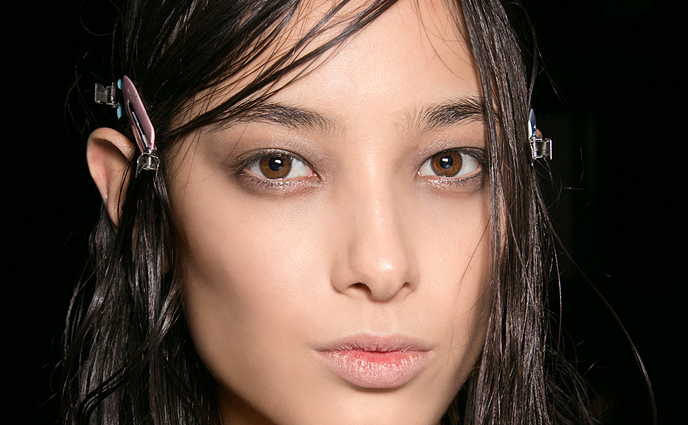Most hair dyes contain cuticle-lifting ingredients like ammonia and ethanolamine. Shampooing your hair also causes the cuticle to lift -- and that's the moment when hair is most vulnerable to damage. This is why it's so important to be gentle with your cleansing routine.
To start, try not to shampoo every day. "I recommend my clients try to only shampoo two to three times a week," says Trujillo. AJ Lordet, master colorist at Pierre Michel Salon in New York City, quips, "My philosophy is don't waste a wash and blow-dry if you're staying home with the dog." Between washes, you can keep your hair looking clean and fluffy with dry shampoo.
Your shampoo of choice is also important. Sulfate-free shampoos for color-treated hair are ideal because sulfates tend to dry hair and strip color. Most hair dyes -- even dark dyes! -- contain moisture-sucking hydrogen peroxide, so a hydrating, sulfate-free shampoo can rebuild your hair's water content.
A color-depositing or toning shampoo designed for your specific hair color is another genius addition to your routine. This is especially true for red hair, which is notoriously quick to fade, and blond hair, which can become greenish or brassy due to the minerals in tap water.
Image via Getty
To start, try not to shampoo every day. "I recommend my clients try to only shampoo two to three times a week," says Trujillo. AJ Lordet, master colorist at Pierre Michel Salon in New York City, quips, "My philosophy is don't waste a wash and blow-dry if you're staying home with the dog." Between washes, you can keep your hair looking clean and fluffy with dry shampoo.
Your shampoo of choice is also important. Sulfate-free shampoos for color-treated hair are ideal because sulfates tend to dry hair and strip color. Most hair dyes -- even dark dyes! -- contain moisture-sucking hydrogen peroxide, so a hydrating, sulfate-free shampoo can rebuild your hair's water content.
A color-depositing or toning shampoo designed for your specific hair color is another genius addition to your routine. This is especially true for red hair, which is notoriously quick to fade, and blond hair, which can become greenish or brassy due to the minerals in tap water.
Image via Getty
Heat-styling devices like blow-dryers, curling irons and flat irons literally crack hair's cuticle, which is why heat-damaged hair often looks frizzy. So you can probably imagine how much your colored hair's compromised cuticle loves getting fried by 400-degree hot tools.
Women with colored or bleached hair should cut back on using heat-styling tools, says Trujillo. "I like to show [my clients] how to style their hair in a way that requires the least amount of heat styling, based on their normal hair care routine," she says. Shampooing less frequently should help you limit heat-styling. Getting more creative with your styling routine (think: braids, ponytails and buns) will also help.
If you heat-style your hair, use tools with ceramic, titanium or ion plates, which reduce damage to hair, and avoid using them on the highest heat setting. Also use a heat-protectant; studies show these products aren't just marketing gimmicks.
Keep in mind that styling products can also contribute to dryness, tangling and breakage in colored hair. Volumizing products should particularly be avoided, since they make hair look fuller by roughing up the cuticle.
Image via Getty
Women with colored or bleached hair should cut back on using heat-styling tools, says Trujillo. "I like to show [my clients] how to style their hair in a way that requires the least amount of heat styling, based on their normal hair care routine," she says. Shampooing less frequently should help you limit heat-styling. Getting more creative with your styling routine (think: braids, ponytails and buns) will also help.
If you heat-style your hair, use tools with ceramic, titanium or ion plates, which reduce damage to hair, and avoid using them on the highest heat setting. Also use a heat-protectant; studies show these products aren't just marketing gimmicks.
Keep in mind that styling products can also contribute to dryness, tangling and breakage in colored hair. Volumizing products should particularly be avoided, since they make hair look fuller by roughing up the cuticle.
Image via Getty
Conditioner doesn't just make color-treated hair look and feel smoother; it actually closes the cuticle, counteracting the cuticle-opening effect of shampoo. A great conditioner also infuses moisturizing ingredients beneath the cuticle, nourishing hair from the inside out.
"Use deep-conditioning treatments every two weeks to prevent breakage," advises Tym Wallace, a celebrity hairstylist. A great conditioning mask will "nourish the hair and scalp and alleviate dryness, which can lead to hair breakage," he says.
Trujillo recommends layering conditioning hair products on color-treated or bleached hair. "I make sure all my clients have a leave-in conditioner ... a good oil or serum, and a good hair mask," she says. Focus any leave-in hydrating products on the ends of hair, where you need moisture most.
Image via Getty
"Use deep-conditioning treatments every two weeks to prevent breakage," advises Tym Wallace, a celebrity hairstylist. A great conditioning mask will "nourish the hair and scalp and alleviate dryness, which can lead to hair breakage," he says.
Trujillo recommends layering conditioning hair products on color-treated or bleached hair. "I make sure all my clients have a leave-in conditioner ... a good oil or serum, and a good hair mask," she says. Focus any leave-in hydrating products on the ends of hair, where you need moisture most.
Image via Getty
Crap news for outdoorsy types: UV light is a major softness- and color-sucker for hair. Sun exposure leeches proteins and pigment from hair, making a UV-protecting product essential for colored hair. Luckily, there are tons of sprays, serums, stylers and masks infused with sunscreen that make protecting your hair from UV damage incredibly easy. Another simple solution: Wear a hat when you're outside.
Chlorine and salt water are two other warm-weather culprits that hurt colored and bleached hair. Salt water, of course, dehydrates hair. But chlorine is even more nefarious than salt water: It swells your hair's cuticles, breaks its chemical bonds, deposits color-distorting minerals and saps it of melanin. When you go swimming, limit the amount of salt water or chlorinated water that your hair absorbs by pre-wetting it with tap water and slicking on some conditioner.
Image via Getty
Chlorine and salt water are two other warm-weather culprits that hurt colored and bleached hair. Salt water, of course, dehydrates hair. But chlorine is even more nefarious than salt water: It swells your hair's cuticles, breaks its chemical bonds, deposits color-distorting minerals and saps it of melanin. When you go swimming, limit the amount of salt water or chlorinated water that your hair absorbs by pre-wetting it with tap water and slicking on some conditioner.
Image via Getty
You might be looking forward to your next hair-coloring sesh like it's Christmas morning, but don't overdo it. Wait at least five or six weeks between coloring services to keep your hair healthy. At-home tinted glosses and root touch-up products can keep your color looking fresh for weeks and weeks. When it's time to color again, you or your stylist should touch up only the roots -- no double-processing your ends, especially if you bleach.
Even if you're growing out your hair, getting a quick trim with each touch-up is ideal. If you're scissor-shy, ask your stylist to "dust" the ends of your hair, which involves trimming a quarter-inch or less to eliminate split ends.
Remember: Healthy hair holds onto color better than unhealthy hair. The better you care for your hair, the less often you'll be hankering for a color service.
Image via Getty
Even if you're growing out your hair, getting a quick trim with each touch-up is ideal. If you're scissor-shy, ask your stylist to "dust" the ends of your hair, which involves trimming a quarter-inch or less to eliminate split ends.
Remember: Healthy hair holds onto color better than unhealthy hair. The better you care for your hair, the less often you'll be hankering for a color service.
Image via Getty



